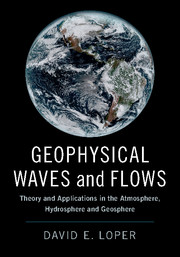Book contents
- Frontmatter
- Contents
- Preface
- Part I Introductory Material
- Part II Kinematics, Dynamics and Rheology
- Part III Waves in Non-Rotating Fluids
- Part IV Waves in Rotating Fluids
- Part V Non-Rotating Flows
- Part VI Flows in Rotating Fluids
- Part VII Silicate Flows
- 29 Equations Governing Silicate Flows
- 30 Cooling the Earth
- 31 Cooling the Mantle
- 32 Cooling the Core
- 33 Overview of Volcanic Flows
- 34 Flow in Volcanic Conduits
- 35 Lava Flows
- Part VIII Fundaments
30 - Cooling the Earth
from Part VII - Silicate Flows
Published online by Cambridge University Press: 26 October 2017
- Frontmatter
- Contents
- Preface
- Part I Introductory Material
- Part II Kinematics, Dynamics and Rheology
- Part III Waves in Non-Rotating Fluids
- Part IV Waves in Rotating Fluids
- Part V Non-Rotating Flows
- Part VI Flows in Rotating Fluids
- Part VII Silicate Flows
- 29 Equations Governing Silicate Flows
- 30 Cooling the Earth
- 31 Cooling the Mantle
- 32 Cooling the Core
- 33 Overview of Volcanic Flows
- 34 Flow in Volcanic Conduits
- 35 Lava Flows
- Part VIII Fundaments
Summary
Earth cools its mantle and core by casting off heat to outer space, with the heat being transported upward through the mantle by a combination of convective motions in the interior and conduction near the top and bottom surfaces. The top thermal boundary layer is the lithosphere, and the bottom layer is called the D̋ layer. A thermal boundary layer has existed at the top of the mantle since the Earth accreted as a hot planetary body some 4.53 ×109 years ago, but a thermal layer exists at the bottom of the mantle now only because the mantle has cooled more rapidly than the core since accretion. In what follows, we will be interested in the current convective state of the mantle, and will not investigate the thermal history of the mantle.
The mantle can directly transfer its heat to the surface, but heat from the core must be transmitted upward through the mantle. This means that the mantle is convecting in two distinct modes, with slab convection acting to cool the mantle and plume convection acting to cool the core; these two modes of cooling are investigated and discussed in Chapters 31 and 32, respectively. But before getting into that, let's briefly discuss plate tectonics (in the following section), slabs and plumes (in § 30.2), volcanism (in § 30.3) and radioactivity (in § 30.5) and quantify the heat flows within the mantle (§ 30.4), the boundary conditions at the core–mantle boundary (§ 30.6) and the temperature profile in the bulk of the mantle (§ 30.7). A comprehensive summary of the structure of the convecting mantle may be found in Davies and Richards (1992).
Plate Tectonics
Although it took people a long while to recognize because of the slow speeds (typically a few centimeters per year) involved, it is now clear that Earth's surface is divided into a set of nearly rigid tectonic plates that move relative to each other. The current configuration of the plates is illustrated in Figure 30.1 and the current motions of Earth's 56 lithospheric plates are given in Argus et al. (2011).
Information
- Type
- Chapter
- Information
- Geophysical Waves and FlowsTheory and Applications in the Atmosphere, Hydrosphere and Geosphere, pp. 323 - 333Publisher: Cambridge University PressPrint publication year: 2017
